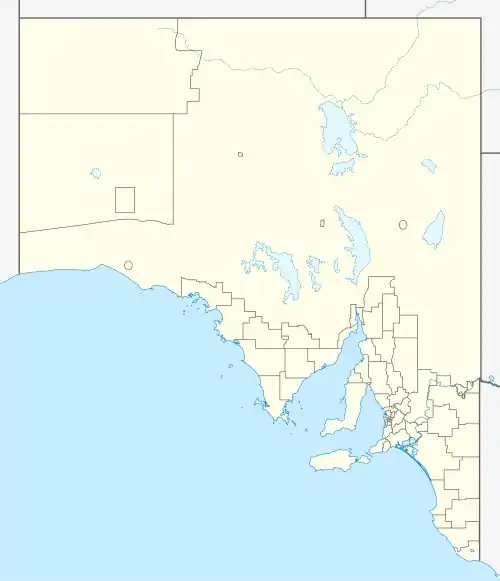| Ravine des Casoars Wilderness Protection Area Cape Borda[1]& Flinders Chase[2], South Australia | |
|---|---|
 Ravine des Casoars Wilderness Protection Area | |
| Nearest town or city | Kingscote |
| Coordinates | 35°50′29″S 136°42′56″E / 35.84139°S 136.71556°E |
| Established | 15 October 1993[4] |
| Area | 413.63 km2 (159.7 sq mi)[3] |
| Managing authorities | Department for Environment and Water |
| See also | Protected areas of South Australia |
Ravine Des Casoars Wilderness Protection Area is a protected area located on the west end of Kangaroo Island in South Australia about 80 km (50 mi) west of Kingscote. It was established in 1993 on land previously part of the Flinders Chase National Park.
Description
Location
Ravine des Casoars Wilderness Protection Area is located at the north-western end of Kangaroo Island in South Australia approximately 80 kilometres (50 mi) west of Kingscote.[5] It is located within the gazetted localities of Cape Borda and Flinders Chase.[1][2]
Extent
The wilderness protection area occupies a parcel of land which is bounded to the south by the West Bay Road and the West Melrose Track, to the east by the West End Highway, the north in part by the Playford Highway and the remainder being the coastline down to mean low water mark from the cove known as Harvey's Return in the north-east to West Bay in the west. The coastline boundary, however, does exclude the former lighthouse reserve at Cape Borda which is part of the Flinders Chase National Park.[5][6]
Protected area designation
The Wilderness Protection Area is classified as an IUCN Category Ib protected area.[3]
History and prior use of land
The wilderness protection area was proclaimed on 15 October 1993, "in order to protect and preserve the outstandingly high wilderness qualities of the area."[4][5] It was named after the Ravine des Casoars, a valley and associated drainage basin located in the northern half of the wilderness protection area. Previously, the land had been part of the Flinders Chase National Park and its predecessors since 1919. Prior to being part of a protected area, the land which had never been cleared by European colonists for agricultural or any other purpose appears to have supported Aboriginal people on the basis of archaeological evidence. As of 1999, radiocarbon dating of material recovered via archaeological excavation from sites at Cape du Couedic and Rocky River just outside the wilderness protection area's southern boundary suggest Aboriginal presence from approximately 7,500 years BP to as recent as 350–400 years BP.[7]
Wilderness qualities
The following qualities have been identified by the government agency managing the wilderness protection area:[8]
The extensive woodlands and nature forests are virtually pristine. The area contains several complete natural drainage systems, from watershed to their discharge at sea. Wilderness quality is recorded as high over the entire area except where it is reduced in a narrow north-south band by the presence of Shackle Road, an unsealed public access road. The vegetation is biologically intact and many endemic plants are present.
Visitor services
The wilderness protected area can be visited on foot via the following walking and trekking trails which connect locations both in the wilderness protection area and the Flinders Chase National Park.
The ‘Return Road Hike’ is a walking trail of 4.5 kilometres (2.8 miles) length that starts at Harvey's Return and finishes at the Cape Borda Lightstation.[9]
The ‘Flinders Chase Coastal Trek’ is a trekking trail between Cape du Couedic and the Ravine Des Casoars car park which located on the north side of the ravine at the southern end of Ravine Road. The trekking trail consists of three sections - Cape Du Couedic to Snake Lagoon (length of 16 kilometres (9.9 miles)), Snake Lagoon to West Bay (length of 20 kilometres (12 miles)) and West Bay to Ravine Des Casoars car park (length of 18 kilometres (11 miles)).[10]
References
- 1 2 "Search result for "Cape Borda (Locality Bounded)" (Record no SA0050434 ) with the following layers being selected - "Suburbs and Localities" and "Road Labels"". Department of Planning, Transport and Infrastructure. Retrieved 6 March 2016.
- 1 2 "Search result for "Flinders Chase (Locality Bounded)" (Record no SA0058416 ) with the following layers being selected - "Suburbs and Localities" and "Road Labels"". Department of Planning, Transport and Infrastructure. Retrieved 6 March 2016.
- 1 2 3 "Terrestrial Protected Areas of South Australia (refer 'DETAIL' tab )". CAPAD 2016. Australian Government, Department of the Environment (DoE). 2016. Retrieved 21 February 2018.
- 1 2 Wiese, B.J. (15 October 1993). "WILDERNESS PROTECTION ACT 1992 SECTION 22(1): CONSTITUTION OF RAVINE DES CASOARS WILDERNESS PROTECTION AREA" (PDF). The South Australian Government Gazette. Government of South Australia. p. 1755. Retrieved 25 January 2019.
- 1 2 3 "Flinders Chase National Park, Kelly Hill Conservation Park, Ravine des Casoars Wilderness Protection Area and Cape Bouguer Wilderness Protection Area Management Plans" (PDF). Department for Environment, Heritage and Aboriginal Affairs. 1999. p. 6. Retrieved 1 May 2014.
- ↑ "Parks of Kangaroo Island" (PDF). Department for Environment and Natural Resources. 2012. p. 9. Archived from the original (PDF) on 14 May 2013. Retrieved 1 May 2014.
- ↑ Robinson, A. C.; Armstrong, D. M., eds. (1999). A Biological Survey of Kangaroo Island, South Australia, 1989 & 1990 (PDF). Adelaide, SA: Heritage and Biodiversity Section, Department for Environment, Heritage and Aboriginal Affairs, South Australia. p. 35. ISBN 0-7308-5862-6. Retrieved 1 May 2014.
- ↑ "Wilderness Advisory Committee Annual Report 2012-13" (PDF). Annual Report: 18. September 2013. ISSN 1832-9357. Retrieved 17 March 2014.
- ↑ "Ravine des Casoars WPA - Return Road Hike". Office for Recreation & Sport. 15 April 2014. Retrieved 1 May 2014.
- ↑ "TREKKING INFORMATION SHEET - Flinders Chase Coastal Trek, Flinders Chase National Park and Ravine des Casoars Wilderness Protection Area, Kangaroo Island" (PDF). Department of Environment, Water and Natural Resources. Retrieved 1 May 2014.